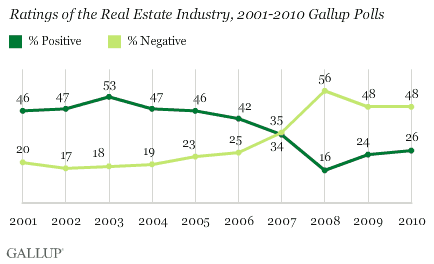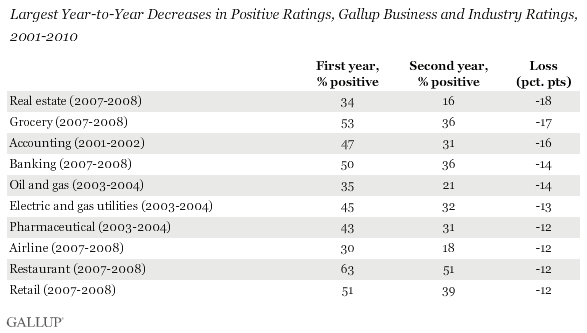PRINCETON, NJ -- Americans rate the real estate industry much more negatively than positively, the third year in a row Gallup has found a net-negative evaluation of this industry.

Real estate industry ratings began to decline sharply in 2007 before bottoming out in 2008. Nearly all of the 25 industries included in Gallup's annual ratings saw their images decline that year as the recession took hold, but the 18 percentage-point drop in real estate ratings was the largest. In fact, it is the largest one-year drop Gallup has measured for any industry in the 10-year history of this question. (See the table on page 2 of the article for full details.) That drop coincided with the subprime mortgage crisis that led to sharp increases in foreclosures and sharp decreases in home values.
The image of the real estate industry recovered somewhat last year, but is essentially flat in the latest update, based on an Aug. 5-8 Gallup poll. Home sales picked up a bit in late 2009 and early 2010, thanks to the government's first-time homebuyer tax-credit program. But since that program expired, sales have slowed considerably.
The real estate industry's ratings remain well below where they were from 2001-2006, when Americans viewed the industry on balance positively, during an era of continually rising housing prices.
On a relative basis, the real estate industry ranks near the bottom of the list of 25 industries Gallup routinely tests. In fact, this year only the oil and gas industry receives a lower percentage of positive ratings (20%). However, a total of four industries (oil and gas, the federal government, banking, and healthcare) receive a greater proportion of negative ratings than does real estate.
Bottom Line
Though Americans' views of the real estate industry have improved from their low point two years ago, they remain well below where they were when the housing market was booming. When Gallup has seen sharp one-year drops in the way Americans rate certain industries, they are usually in response to real-world events that affect the industry. In some cases, the industry's image has recovered within a year, as with the accounting industry in 2003 and the grocery industry last year. However, some industries (such as banking) have seen sustained lower ratings, suggesting a more fundamental alteration in the way Americans view them.
That appears to be the case with the real estate industry, and its ratings are likely to remain depressed as long as the housing market remains troubled. The real key for the real estate industry is whether Americans will revert to a more positive than negative evaluation of it once the housing market improves.
Results for this Gallup poll are based on telephone interviews conducted Aug. 5-8, 2010, with a random sample of 508 adults, aged 18 and older, living in the continental U.S., selected using random-digit-dial sampling.
For results based on the total sample of national adults, one can say with 95% confidence that the maximum margin of sampling error is ±5 percentage points.
Interviews are conducted with respondents on landline telephones (for respondents with a landline telephone) and cellular phones (for respondents who are cell phone-only). Each sample of 1,000 includes a minimum quota of 150 cell phone-only respondents and 850 landline respondents, with additional minimum quotas among landline respondents for gender within region. Landline respondents are chosen at random within each household on the basis of which member had the most recent birthday.
Samples are weighted by gender, age, race, education, region, and phone lines. Demographic weighting targets are based on the March 2009 Current Population Survey figures for the aged 18 and older non-institutionalized population living in continental U.S. telephone households. All reported margins of sampling error include the computed design effects for weighting and sample design.
In addition to sampling error, question wording and practical difficulties in conducting surveys can introduce error or bias into the findings of public opinion polls.
For more details on Gallup's polling methodology, visit https://www.gallup.com/.

